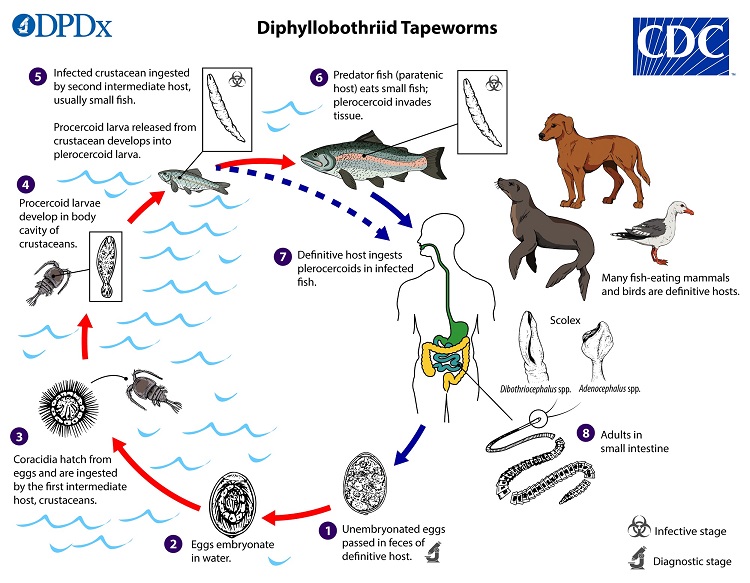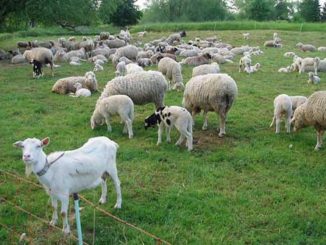Diphyllobothriasis is also called as ‘Fish tapeworm disease’.
Etiology
Caused by cestode Diphyllobothrium latum (also sometimes caused by other species like D.pacificum & D.nihonkaiense). It occurs in small intestine of man, dog, cat, polar bear etc. Adults are 2-12m long and yellowish grey in colour. Eggs in faeces are light brown in colour and operculate. Adult parasite can live for a period of > 20 years.
Life cycle and Transmission
Infection occurs in those areas where eating of raw fish is practiced. Many dishes such as sushi, sashimi, poke, ceviche, koi pla etc. are served across many countries across globe which contain raw fish. Incidence of infection is higher in dogs and pigs where they are offered raw fish.

There are four stages of life cycle:
- Adult
- Coracidium
- Procercoid
- Plerocercoid
Life cycle starts with adult parasite in small intestine of human. Adult parasite releases eggs along with faeces of human. It can produce around 1,00,000 eggs daily.
![]()
These faeces containing eggs comes into contact with a waterbody. The eggs enter into water. They require 11-15 days’ time and 15-25ºC temperature to transform into next stage i.e. coracidium.
![]()
Cyclops present in water ingest coracidium. Coracidium takes 2-3 weeks’ time to transform into next stage i.e.procercoid.
![]()
Fish consume Cyclops containing procercoid. Procercoid penetrates the wall of intestine and migrates into muscles of fish where it get transformed into next stage i.e.Plerocercoid (infective stage)
![]()
Plerocercoid enters human body when we consume raw, uncooked fish. It remains for 4 weeks and then develops into Adult. The adult releases eggs and completes the life cycle. Dogs, cats can also act as host but symptoms rarely appear in them.
Signs and Symptoms
Diarrhoea, Stomach ache, Nausea, Vomition, Megaloblastic anaemia, slight haemorrhage of oral cavity, odema of face and joints, loss in weight, neurological signs etc. are common symptoms observed. There is competition between host and parasite for Vit.B12 which causes anaemia.
Global situation
In early 1970’s, Diphyllobothriosis was estimated to affect 9 million people globally. The disease includes both freshwater and marine fishes. In recent times the disease is known to affect 20 million people worldwide.
Before year 2000, the prevalence of disease was much higher in countries of North America i.e. USA, Canada and Alaska due to presence of large water bodies and freshwater lakes like Lake Superior, Lake Manitoba etc.
Around 125-200 cases were reported from different parts of this region during period of 1978-1981.Prevalence was also higher in many European countries, particularly in area of Baltic countries i.e., Estonia, Latvia, Lithuania etc. A total of 715 and 400 cases were seen in Estonia in the year 1990 and 1997 respectively.
Scandinivian countries like Finland, Sweden were also affected. In Finland almost 20 cases were found annually whereas in Sweden 10-50 cases were observed annually. Countries like Austria, Czech, Belgium, Netherlands and Spain remained disease free.
After 20th century the disease was much more controlled in North America with very rare cases reported but the trend with European countries was not the same. Countries of sub alpine region were also involved like Switzerland, Italy, France etc. with more than 330 cases reported from the year 2002-07. A study was conducted between 2003-05 in lakes of Switzerland and Italy in which Perch fishes were examined. In Lake Geneva 4-10% of total fishes were found affected with D.latum whereas in lake Maggiore 14% of total fishes were affected. Between 2002-07 more than 230 cases were reported from cantons of Geneva and 44 cases were reported in towns situated on the shores of Lake Leman in France.
Cases were also found in Russia. Disease has also been found in South American countries like Brazil, Chile, Argentina, Peru and Ecuador. Diphyllobothrium pacificum is also found responsible for causation of disease along with D.latum . There were outbreaks in Rio de Janeiro and Sao Paulo cities of Brazil in 2006 after consumption of dish ‘sushi’ which contains raw fish. A total of 60 cases have been reported from Peru.
In Asia around 100 and 45 cases were reported from Japan and South Korea respectively where infection caused by Diphyllobothrium nihonkaiense was found. However in other parts like Middle East, Indian subcontinent, Indonesia etc. very less cases were reported. In Australia and Africa cases haven’t been reported yet. Economic impact is also seen in the affected areas.
Situation in India
In India very less cases are reported till date. All the cases reported were from South India, mainly Puducherry and Tamil Nadu. 1 case was reported in the year 1998. A nine year old girl was also found positive and admitted to Prathima Institute of Medical Sciences. History of recurrent abdominal pain. She was a non-vegetarian and had a history of eating fish. She had continuous fever for three days. Her stools were watery in consistency
A five-year-old boy of fisherman community was reported positive from Puducherry. He was treated with Praziquintal 400 mg single dose.
In April 2017, a 40 years old lady in Karnataka with history of abdomen discomfort and cream-coloured structures in stool came to the hospital. She was an occasional fish eater. During the routine check-up of stool, tape like structures were observed. Confirmation of the Diphyllobothrium latum was done on the basis of egg morphology. Observation of blood smear picture showed hypersegmented neutrophils, an indication for megaloblastic anaemia. She was given niclosamide single dose treatment.
Treatment
Praziquintal can be given @ 25mg/kg body weight. Other drugs like Niclosamide (2g in adults) and Quinacrine can also be used. In dogs, Diphenthane-70 can be administered @ 200 mg/kg.
Prevention
- Post-harvest controls, such as proper fish processing and preparation of food, are the most effective measures to consumer protection. Prevention involves freezing (at -15 to -25ºC) or cooking of fish. Raw fish should not be consumed. Canned fish is safe but smoked fish is safe only if the fish was frozen appropriately before smoking to kill any parasites.
- Animals should not be given raw fish.
- Prevention of contamination of water body with sewage.
- Defecation should not be done in open. Animals should not be allowed to defecate near water bodies.
- Proper care of hygiene should be taken.
- Affected patient should take proper treatment
References
- Scholz T, Garcia H, Wicht B. 2009. Update on the Human Broad Tapeworm (Genus Diphyllobothrium), Including Clinical Relevance. Clinical Microbiology Review;22(1):146-160.
- Durrani M, Basit H, Blazar E. (2020). Diphyllobothrium Latum. Treasure Island.
- Susan M, Frank O, Richards Jr. (2017). Principles and practice of Pediatric Infectious Diseases. Science Direct. 279:1394-1397.
- Lodhi, M. I., Kuknoor, G. R., & Katakol, S. (2017). A rare case of Diphyllobothriasis and Megaloblastic anaemia in a middle-aged lady from South India. 4(4), 471–472.
| The content of the articles are accurate and true to the best of the author’s knowledge. It is not meant to substitute for diagnosis, prognosis, treatment, prescription, or formal and individualized advice from a veterinary medical professional. Animals exhibiting signs and symptoms of distress should be seen by a veterinarian immediately. |






Be the first to comment